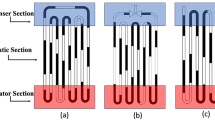Abstract
Nowadays, modern engines control a wide range of parameters in order to meet desired functions and standards. Measurement of mechanical systems has long been an issue for engineers and researchers. Sensors are the devices which monitor the mentioned parameters. Therefore, the accuracy of sensors is an important consideration. Extracting the exact temperature of the coolant (coolant content: 50% water and 50% ethylene glycol) in engine cooling system by the sensors and also thermostat depends largely on their correct placement. The task of controlling coolant flow rate and engine temperature is done by the thermostat mounted in the cooling system. In the present work, the coolant temperature behavior has been investigated due to inappropriate design of the thermostat housing in a gasoline engine. Considering the importance of the cooling issue, the problem has been solved by two methods, namely test and numerical solution. The results obtained from these methods have had a good convergence with each other. Warm-up test results show that thermostat is not capable of sensing the real temperature of the coolant. According to the results, a design change has been made in the thermostat housing. The new sample of thermostat housing has been tested and also numerically analyzed. A good agreement between the test results and numerical solution has been observed. The opening temperature and time of the thermostat in new housing have been reduced by more than 9 °C and nearly 149 s (about 2.5 min), respectively.













Similar content being viewed by others
Abbreviations
- °C:
-
Celsius degree
- CFD:
-
Computational fluid dynamics
- IC:
-
Internal combustion
- k:
-
Thermal conductivity of the fluid (W m−1 K)
- Nu:
-
Nusselt number (–)
- ON:
-
Octane number (–)
- Opt.:
-
Optimum
- rpm:
-
Engine speed (Rev. per minute)
- TC:
-
Turbocharger
References
Heywood JB. Internal combustion engine fundamentals. 1st ed. McGraw-Hill: New York; 1988.
Mitchell T, Salah M, Wagner J, Dawson D. Automotive thermostat valve configurations: enhanced warm-up performance. ASME J Dyn Syst Meas Control. 2009;131:044501.
Picarelli A, Galindo E, Diaz G. Thermal shock testing for engines in dymola. In: Proceedings of the 10th international modelica conference, March 10–12, 2014, Lund, Sweden.
Koch FW, Haubner FG. Cooling system development and optimization for DI engines. Warrendale: SAE International; 2000.
Mohamed ES. Development and analysis of a variable position thermostat for smartcooling system of a light duty diesel vehicles and engine emissions assessment during NEDC. Appl Therm Eng 2016;99:358–72.
Haghighat AK, Roumi S, Madani N, Bahmanpour D, Olsen MG. An intelligent cooling system and control model for improved engine thermal management. Appl Therm Eng 2018;128:253–63.
Kang H, Ahn H, Min K. Smart cooling system of the double loop coolant structure with engine thermal management modelling. Appl Therm Eng 2015;79:124–31.
Mohamed ED. Design and experimental investigation on an electromagnetic engine valve train. SAE technical papers. 2011.
Incropera FP, Dewitt DV, Bergman TL, Levine AS. Fundamentals of heat and mass transfer. 6th ed. New York: Wiley; 2012.
Wagner JR, Srinivasan V, Dawson DM, Marotta EE. Smart thermostat, coolant pump, control for engine thermal management systems. In: SAE, world congress & exhibition, Detroit, Michigan, USA; 2003.
Li D, Wu Y, Liu C, Zhang G, Arici M. Numerical investigation of thermal and optical performance of window units filled with nanoparticle enhanced PCM. Int J Heat Mass Transf. 2018;125:1321–32.
Li D, Wu Y, Liu C, Zhang G, Arici M. Energy investigation of glazed windows containing nano-PCM in different seasons. Energy Convers Manag. 2018;172:119–28.
Baniamerian Z, Nazoktabar M, Mehdipour R. Simulation of boiling heat transfer within water jacket of 4-cylinder gasoline engine. Int J Eng IJE Trans C Asp. 2014;27(12):1928–35.
Pang SC, Kalam MA, Masjuki HH, Hazrat MA. A review on air flow and coolant flow circuit in vehicles’ cooling system. Int J Heat Mass Transf. 2012;55(23–24):6295–306.
Cengel YA. Heat and mass transfer. 2nd ed. New York: McGraw-Hill; 2015. p. 466.
Author information
Authors and Affiliations
Corresponding author
Additional information
Publisher's Note
Springer Nature remains neutral with regard to jurisdictional claims in published maps and institutional affiliations.
Rights and permissions
About this article
Cite this article
Nazoktabar, M., Arshtabar, K. & Mohammadkhani, H. Investigating the effect of coolant’s heat transfer type on thermostat placement. J Therm Anal Calorim 139, 2519–2526 (2020). https://doi.org/10.1007/s10973-019-08805-5
Received:
Accepted:
Published:
Issue Date:
DOI: https://doi.org/10.1007/s10973-019-08805-5




